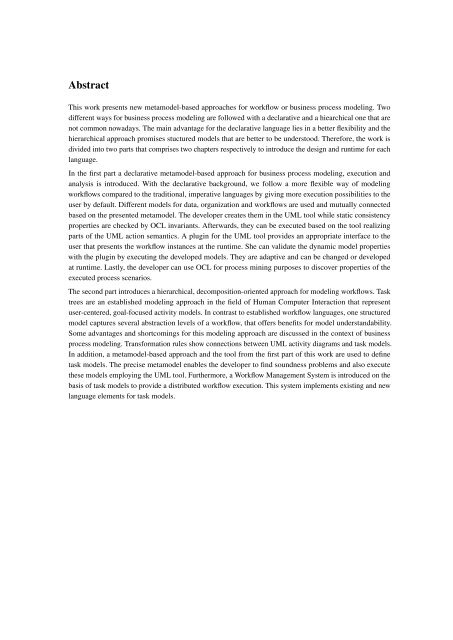Metamodellbasierte und hierarchieorientierte ... - RosDok
Metamodellbasierte und hierarchieorientierte ... - RosDok
Metamodellbasierte und hierarchieorientierte ... - RosDok
Sie wollen auch ein ePaper? Erhöhen Sie die Reichweite Ihrer Titel.
YUMPU macht aus Druck-PDFs automatisch weboptimierte ePaper, die Google liebt.
Abstract<br />
This work presents new metamodel-based approaches for workflow or business process modeling. Two<br />
different ways for business process modeling are followed with a declarative and a hiearchical one that are<br />
not common nowadays. The main advantage for the declarative language lies in a better flexibility and the<br />
hierarchical approach promises stuctured models that are better to be <strong>und</strong>erstood. Therefore, the work is<br />
divided into two parts that comprises two chapters respectively to introduce the design and runtime for each<br />
language.<br />
In the first part a declarative metamodel-based approach for business process modeling, execution and<br />
analysis is introduced. With the declarative backgro<strong>und</strong>, we follow a more flexible way of modeling<br />
workflows compared to the traditional, imperative languages by giving more execution possibilities to the<br />
user by default. Different models for data, organization and workflows are used and mutually connected<br />
based on the presented metamodel. The developer creates them in the UML tool while static consistency<br />
properties are checked by OCL invariants. Afterwards, they can be executed based on the tool realizing<br />
parts of the UML action semantics. A plugin for the UML tool provides an appropriate interface to the<br />
user that presents the workflow instances at the runtime. She can validate the dynamic model properties<br />
with the plugin by executing the developed models. They are adaptive and can be changed or developed<br />
at runtime. Lastly, the developer can use OCL for process mining purposes to discover properties of the<br />
executed process scenarios.<br />
The second part introduces a hierarchical, decomposition-oriented approach for modeling workflows. Task<br />
trees are an established modeling approach in the field of Human Computer Interaction that represent<br />
user-centered, goal-focused activity models. In contrast to established workflow languages, one structured<br />
model captures several abstraction levels of a workflow, that offers benefits for model <strong>und</strong>erstandability.<br />
Some advantages and shortcomings for this modeling approach are discussed in the context of business<br />
process modeling. Transformation rules show connections between UML activity diagrams and task models.<br />
In addition, a metamodel-based approach and the tool from the first part of this work are used to define<br />
task models. The precise metamodel enables the developer to find so<strong>und</strong>ness problems and also execute<br />
these models employing the UML tool. Furthermore, a Workflow Management System is introduced on the<br />
basis of task models to provide a distributed workflow execution. This system implements existing and new<br />
language elements for task models.
















